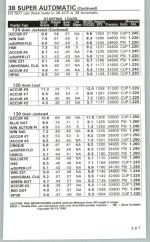Benchmark12
Inactive
Is it safe, acceptable or common practice To use 9mm bullets for reloading 38 Super? Is it just a matter of matching up acceptable diameter and grains to ensure it does not exceed the max velocity? I believe the length plays a role in it, but does that only effect accuracy? Thanks. Any other insight is appreciated, not wanting to ruin the bore or whatever else. I was looking at using this for doing it as it seams to coincide with measurements. I want to use TMJ copper plated.
I was looking at buying on of these, but unsure which would be recommended.
[IMG]
9mm- 147 RN
9mm- 147 RN
www.xtremebullets.com
9mm- 147 RN
Diameter: 0.356
or
[IMG]
9mm-124 RN
9mm-124 RN
www.xtremebullets.com
9mm-124 RN
Diameter: 0.355
I was looking at buying on of these, but unsure which would be recommended.
[IMG]
9mm- 147 RN
9mm- 147 RN
www.xtremebullets.com
9mm- 147 RN
Diameter: 0.356
or
[IMG]
9mm-124 RN
9mm-124 RN
www.xtremebullets.com
9mm-124 RN
Diameter: 0.355

